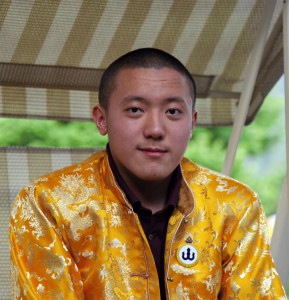Friday
Featured Stories, Mountain StatesKhyentse Yangsi Rinpoche and the Rangjung Peme Nyingtik Transmission
This article was compiled and edited by Joey Waxman, with the help of others, on behalf of Dzigar Kongtrul Rinpoche’s sangha, Mangala Shri Bhuti. Mangala Shri Bhuti is hosting the visit of Khyentse Yangsi Rinpoche to Colorodo this August.
During his first visit to the United States this summer, Khyentse Yangsi Rinpoche, the tulku of the great master and Rimé scholar, Dilgo Khyentse, will bestow the empowerment of the Rangjung Peme Nyingtik.
The Rangjung Peme Nyingtik has an inspiring history. It is a terma sadhana of the Three Roots of the Nyingma tradition, discovered by His Holiness Dilgo Khyentse Rinpoche.
Revelation of the Rangjung Peme Nyingtik
Whenever he was in retreat in Tibet, Dilgo Khyentse would recite a prayer composed by Jamyang Khyentse Wangpo based on the Eight Herukas. When he was twenty-one, while practicing at dawn, Khyentse Rinpoche perceived his body as the yidam deity with the eight herukas abiding in various parts of his body. This experience remained for a long time.
Later, he went to Dzongsar Monastery in Kham to receive teachings from one of his main masters, Jamyang Khyentse Chokyi Lodro. While there, a group of people asked him for the transmission of Guru Rinpoche’s Seven-Chapter Supplication. In the annotations between each chapter are various stories about Guru Rinpoche. (Guru Rinpoche is an epithet for Padmasambhava, meaning “the precious teacher.”) As Khyentse Rinpoche was reading one of these, all of phenomena changed and the place became Samye during Guru Rinpoche’s time. Guru Rinpoche’s forms in various sizes showered down and dissolved into him. This brought back some visionary experiences he had had while doing retreat on the Eight Herukas.
Suddenly, the text and practice containing the Three Roots came clearly and completely into his mind: the Rangjung Peme Nyingtik, with Guru Padmasambhava as the lama, Hayagriva as the yidam, and Vajravarahi as the dakini.
Transmission of the Terma
Khyentse Rinpoche wrote the text down and offered it to Chokyi Lodro, who said that the wording was very similar to that used in ancient terma. In addition, he said that this practice was supposed to have been revealed by Jamyang Khyentse Wangpo, but circumstances had not allowed it then, so it had come to Dilgo Khyentse Rinpoche. Chokyi Lodro asked to receive the empowerment, and Khyentse Rinpoche later wrote a daily sadhana.
During the Cultural Revolution, a student hid the text in a cave to protect it, but it was destroyed in a fire. Many years later, when Dilgo Khyentse visited Yanglesho, the sacred cave of Guru Rinpoche in Nepal, he was performing a ganachakra offering with Kyabje Trulshik Rinpoche, when suddenly he realized that this was the cave he had often seen in his childhood dreams.
Trulshik Rinpoche did prostrations and insistently requested Rinpoche to write down whatever came into his mind. This is when he wrote down the Rangjung Peme Nyingtik for the second time. Many years later, when Tibet became more open, a monk from Surmang came with copies he had made of the original texts before they had been destroyed. The words were almost identical to the ones Khyentse Rinpoche had written at Yanglesho.
Many people began to request teachings on this terma cycle, and Khyentse Rinpoche gave the empowerment, reading transmission, and commentary to his close students a number of times.
Rangjung Peme Nyingtik and Shambhala
In the Shambhala mandala, there have been two main branches of the Vajrayana path after one completes Chakrasamvara practice: Kagyu and Nyingma. The Nyingma branch involves three ngondros: Konchok Chidu, Longchen Nyingtik, and Rangjung Peme Nyingtik.
In 1987, honoring commitments he had made to the Chogyam Trungpa Rinpoche, Dilgo Khyentse bestowed the Three Roots abhishekas for the Konchok Chidu and Longchen Nyingtik terma cycles in Halifax, Vermont, and Boulder. However, he did not give the abhisheka for his own primary terma cycle, the Rangjung Peme Nyingtik. Since then, those sadhakas who chose to practice the three Nyingma ngondros have been able to practice Konchok Chidu and Longchen Nyingtik but, lacking the abhisheka, have not been able to proceed with the Rangjung Peme Nyingtik cycle. This “gap” will now potentially be filled.
This summer all of us have the great fortune to be able to receive this Three Roots empowerment from Dilgo Khyentse Rinpoche himself, who is finally returning to North America in his new manifestation, as a seventeen-year-old tulku, fully trained in the lineage of his predecessor.
Khyentse Yangsi Rinpoche will visit North American in early August. For more information please visit: http://khyentsevisit2010.org/events/.


















